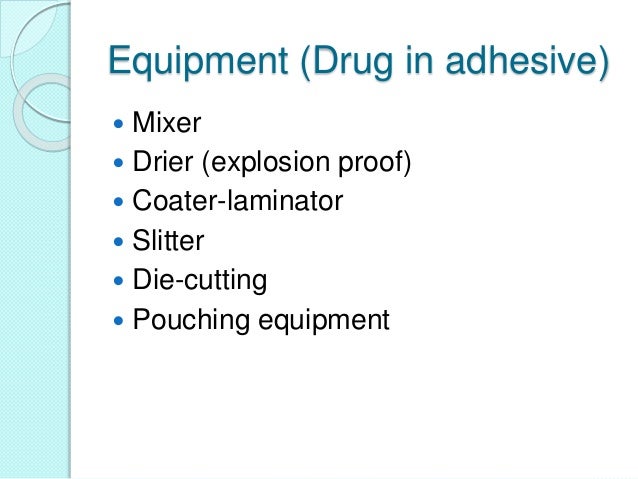Transdermal Patch Manufacturing Equipment
Brand / Product NameCompositionStrengthDosage FormPack SizeTherapeutic CategoryALZAMINE 18Each patch contains:Rivastigmine Base.18 mg9.5 mg for 24 hoursTransdermal Patches5DementiaALZAMINE 9Each patch contains:Rivastigmine Base.9 mg4.6 mg for 24 hoursTransdermal Patches5DementiaASTHEROLEach transdermal patch contains: Tulobuterol.
A transdermal patch which delivers medication is applied to the skin in a medical setting. The patch is labelled with the time and date of administration as well as the administrator's initials.A transdermal patch is a patch that is placed on the to deliver a specific of medication through the skin and into the. Often, this promotes healing to an injured area of the body. An advantage of a transdermal drug delivery route over other types of medication delivery such as oral, topical, intravenous, intramuscular, etc. Is that the patch provides a controlled release of the medication into the patient, usually through either a porous membrane covering a reservoir of medication or through body heat melting thin layers of medication embedded in the adhesive. The main disadvantage to transdermal delivery systems stems from the fact that the skin is a very effective barrier; as a result, only medications whose molecules are small enough to penetrate the skin can be delivered by this method.
A wide variety of pharmaceuticals are now available in transdermal patch form.The first commercially available prescription patch was approved by the U.S. In December 1979. These patches administered for. Contents.Popular uses. The highest selling transdermal patch in the United States of America is the, which releases in controlled doses to help with cessation of. Sample transdermal patches.
On left is a 'reservoir' type, on the right a 'Single-layer Drug-in-Adhesive' version. Both contain exactly the same level of the same active ingredient with identical release rates.There are five main types of transdermal patches.Single-layer Drug-in-Adhesive The adhesive layer of this system also contains the drug. In this type of patch the adhesive layer not only serves to adhere the various layers together, along with the entire system to the skin, but is also responsible for the releasing of the drug. The adhesive layer is surrounded by a temporary liner and a backing.Multi-layer Drug-in-Adhesive The multi-layer drug-in-adhesive patch is similar to the single-layer system; the multi-layer system is different, however, in that it adds another layer of drug-in-adhesive, usually separated by a membrane (but not in all cases). One of the layers is for immediate release of the drug and other layer is for control release of drug from the reservoir.
This patch also has a temporary liner-layer and a permanent backing. The drug release from this depends on membrane permeability and diffusion of drug molecules.Reservoir Unlike the single-layer and multi-layer drug-in-adhesive systems, the reservoir transdermal system has a separate drug layer. The drug layer is a liquid compartment containing a drug solution or suspension separated by the adhesive layer. The drug reservoir is totally encapsulated in a shallow compartment molded from a drug-impermeable metallic plastic laminate, with a rate-controlling membrane made of a polymer like on one surface. This patch is also backed by the backing layer. In this type of system the rate of release is zero order.Matrix The matrix system has a drug layer of a semisolid matrix containing a drug solution or suspension.
The adhesive layer in this patch surrounds the drug layer, partially overlaying it. Also known as a monolithic device.Vapour Patch In a vapour patch, the adhesive layer not only serves to adhere the various layers together but also to release vapour. Vapour patches release essential oils for up to 6 hours and are mainly used for decongestion. Other vapour patches on the market improve quality of sleep or aid in.Regulatory aspects A transdermal patch is classified by the U.S.
Food and Drug Administration as a combination product, consisting of a combined with a or biological product that the device is designed to deliver. Prior to sale in the United States, any transdermal patch product must apply for and receive approval from the Food and Drug Administration, demonstrating safety and efficacy for its intended use.

References. Segal, Marian. Archived from on 2007-02-10. Retrieved 2007-02-24. Archived from on 2006-12-19. Retrieved 2007-02-12. Nachum Z, Shupak A, Gordon CR (2006).
Transdermal Patch Manufacturing Equipment For Sale

'Transdermal scopolamine for prevention of motion sickness: clinical pharmacokinetics and therapeutic applications'. Clinical Pharmacokinetics. 45 (6): 543–66. Berner B, John VA (February 1994). 'Pharmacokinetic characterisation of transdermal delivery systems'.
Clinical Pharmacokinetics. 26 (2): 121–34. Peck, Peggy (2006-03-01). Retrieved 2010-09-28.
Cabray, Matthew (2006-04-12). Retrieved 2010-09-28. Thirupathi; et al.
Transdermal Patch Suppliers
Retrieved 2018-07-28. Retrieved 2014-06-18. Peck, Peggy (2007-07-10). Retrieved 2011-03-10.
Archived from on 2007-02-20. Retrieved 2007-02-24. Megget, Katrina (2007-09-05). Retrieved 2010-09-28. Silverman, Ed (2008-02-12). Retrieved 2010-09-28. As stated on the packaging and labels of Sandoz-branded Fentanyl Transdermal System products, revised March 2009.
Archived from on March 7, 2009. Retrieved March 9, 2009. Brown, MR: 'Analgesic patches and defibrillators: a cautionary tale', Europace,2009 Nov;11(11):1552-3. Retrieved April 10, 2012.Further reading.
(PDF). Archived from (PDF) on 2007-08-10. Retrieved 2007-02-12.External links.Wikimedia Commons has media related to.
Comments are closed.